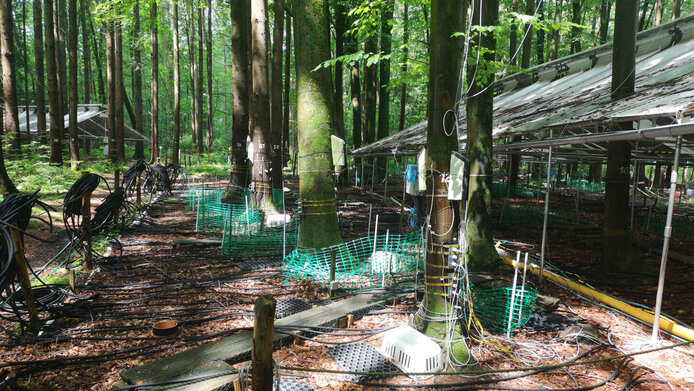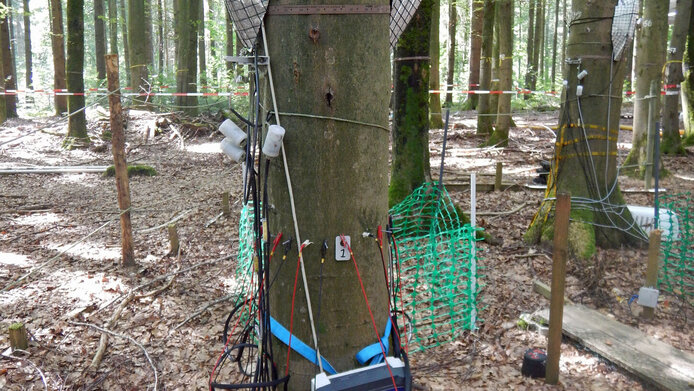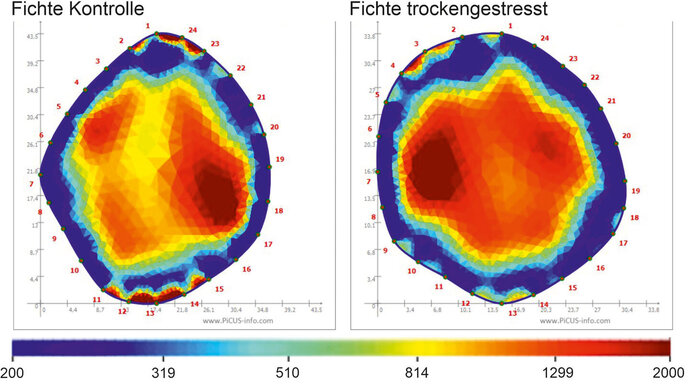What ultrasound can tell us about the forest

“We want to know how beech and spruce trees respond to droughts becoming more frequent and more intense because of climate change – and whether the trees can recover once water is available again,” explains Barbara Beikircher from the University of Innsbruck. This biologist is conducting research at a special place – the “Kranzberg Forest” north of Munich Airport.
Her research is part of the Kranzberg Roof Experiment (KROOF) – a broad-based research project initiated by scientists at Helmholtz Zentrum München and Technische Universität München in 2010. International researchers are investigating how forests are coping with drought stress. The Austrian Science Fund FWF funded Barbara Beikircher's sub-project “Drought acclimation and recovery of beech and Norway spruce”, which she is conducting with her project partners Rainer Matyssek and Thorsten Grams from the Technische Universität München.
In the forest, which was formerly exploited commercially, the researchers selected twelve subplots with 70 to 90 year old beech and spruce trees. Waterproof tarpaulin was used to surround each of these plots to a depth of up to one meter and automatic roofs kept water off the ground on six of these subplots between 2013 and 2019. In the summer of 2019, all roofs were opened and all plots were irrigated. Researchers also had a crane that gave them around-the-clock access to the tree canopies in the respective subplots. “There are very few places in the world where you can do research like this,” says Barbara Beikircher.
How does a tree die of thirst?
Trees absorb water through the roots and transport it to the leaves via the trunk. The leaves have small narrow openings, or stomata, and if these are open, the tree can absorb CO2, and water can evaporate at the same time. “In simple terms you could say that, when exposed to drought stress, the tree is always either starving or dying of thirst. If the stomata are closed, it will starve. If they are open, it will die of thirst if not enough water comes in through the roots,” Beikircher explains.
The strong adhesive forces between the individual water molecules ensure that water rises from the roots to the leaves, propelled by the evaporation on the leaf surface. This transport occurs in the tree’s wood, the xylem, which is composed of many lignified, elongated cells called tracheids and tracheae. In the case of spruce, these conducting vessels are only a few millimeters long and a few micrometers thick. They run upward parallel to each other and are interconnected.
"Embolism" of the conducting vessels
“This conduction system only functions for as long as the water columns in the conduction vessels remain intact. If they break, air will enter the conducting vessel and water transport comes to a standstill. We call that an 'embolism',” notes Barbara Beikircher. The breaking of a fine water column in the conducting vessels produces a sound in the ultrasound range. In order to capture it, the biologist and her team wired trees from root to crown with ultrasonic sensors. It was the first outdoor experiment of this type on this large scale.
If hundreds of thousands of fine water threads break this does not yet constitute a problem, since conducting vessels can fill up again or others can take over from them. This only works up to a degree, however, as Beikircher explains: “Above a certain threshold value, the number of air-filled conductive vessels will be so large that water transport comes to a standstill. In that case, the tree may well die.”
The groans of spruces
After a few days of measurements, Beikircher was able to detect a significantly higher number of signals in the drought-stressed trees than in the control trees. “In addition, we recorded many times more signals in the spruces than in the beeches. Beech trees presumably had it much easier fetching water from the depths owing to to their deep-reaching roots.”
Beikircher also heard differences within a tree. There were hardly any signals in the roots, but many in the canopy. “This confirms our theory that embolism occurs first in the tree crown, because water potentials are lower there.” The drought-stressed spruces also showed reduced performance of photosynthesis. As a result, they grew only a few centimeters a year. “If we had exposed them to stress longer, I'm sure several trees would have died,” says Beikircher.
A look inside
Another method, called electrical resistance tomography, saw the biologist and her team hammering nails around tree trunks to which electrodes were attached. A current was applied across these electrodes and recorded electrical resistances. Since electrical resistance also depends on moisture, the resulting pattern provides a visualization of the distribution of water inside the trunk. The team found that there was significantly less water available in the trunk of drought-stressed trees than in control trees. Spruce trees were also more affected than beech trees.
This was another important insight resulting from the research. While all the classic research parameters indicated that the drought-stressed spruce trees would recover when receiving water again, resistance tomography revealed that the opposite was true. “When investigating this in detail we saw that the outer areas were well supplied. But the inner core, which servesas a water reservoir, was depleted. The tree was channeling water outward to continue supplying the branches and leaves. Even after a year, the tree was unable to refill these inner reservoirs,” Beikircher explains. In a follow-up project, the research team intends to find out whether the reservoirs can fill up again. If they can’t, trees could die earlier in future drought events.
Lessons learned
What are the lessons learned from Beikircher’s research about forest management in the climate crisis? “Our measurements confirm that spruce monocultures on dry sites no longer have a future,” she concludes. Additional studies on three-year-old spruce trees in a climate chamber also showed that the young trees can no longer recover in case of severe, prolonged drought and will die. In the forest, they could have a hard time re-growing. Moreover, drought makes trees more susceptible to pests and diseases. Some spruce trees in the Kranzenberg Forest also succumbed to the bark beetle since they were too weak to produce sufficient defense substances.
Barbara Beikircher studied biology/botany at the University of Innsbruck, where she acquired a PhD in ecophysiology. A Hertha Firnberg fellow of the Austrian Science Fund FWF between 2014 and 2020, she now works as a research associate in the Ecophysiology Research Group at the Institute of Botany, University of Innsbruck. Her research interests include stress tolerance and adaptability of economically relevant plants such as fruit trees, spruce or beech, and the hydraulic properties of seedlings and saplings. The project “Drought acclimation and recovery of beech and Norway spruce” was funded by the FWF with 239,000 euros.
Publications
Knüver T., Bär A., Ganthaler A., Gebhardt T. et al.: Recovery after long-term summer drought: Hydraulic measurements reveal legacy effects in trunks of Picea abies but not in Fagus sylvatica, in: Plant Biology 2022
Hesse BD., Gebhardt T., Hafner BD., Hikino K. et al: Physiological recovery of tree water relations upon drought release - response of mature beech and spruce after five years of recurrent summer drought, in: Tree Physiology 2022
Tomasella M., Beikircher B., Häberle KH., Hesse B. et al.: Acclimation of branch and leaf hydraulics in adult Fagus sylvatica and Picea abies in a forest through-fall exclusion experiment, in: Tree Physiology 2017







